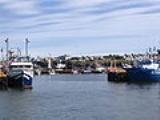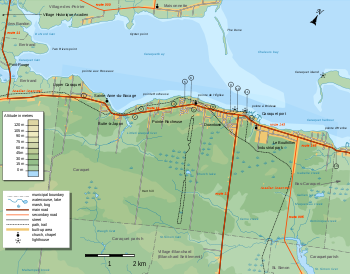
Caraquet, New Brunswick
Encyclopedia
Caraquet is a Canadian
Canada
Canada is a North American country consisting of ten provinces and three territories. Located in the northern part of the continent, it extends from the Atlantic Ocean in the east to the Pacific Ocean in the west, and northward into the Arctic Ocean...
town in Gloucester County
Gloucester County, New Brunswick
Gloucester County is located in the northeastern corner of New Brunswick, Canada. Fishing, mining and forestry are the major industries in the county...
, New Brunswick
New Brunswick
New Brunswick is one of Canada's three Maritime provinces and is the only province in the federation that is constitutionally bilingual . The provincial capital is Fredericton and Saint John is the most populous city. Greater Moncton is the largest Census Metropolitan Area...
.
Location

Chaleur Bay
frame| Satellite image of Chaleur Bay . Chaleur Bay is the large bay opening to the east;the [[Gaspé Peninsula]] appears to the north and the [[Gulf of St...
in the Acadian Peninsula
Acadian Peninsula
The Acadian Peninsula is situated in the northeastern corner of New Brunswick, Canada, encompassing portions of Gloucester and Northumberland Counties. It derives its name from the large Acadian population located there...
, its name is derived from the Mi'kmaq term for meeting of two rivers. The Caraquet River and Rivière du Nord
Rivière du Nord (New Brunswick)
The Rivière du Nord is a river that flows into the Caraquet Bay west of Caraquet, New Brunswick, Canada....
flow into the Caraquet Bay
Caraquet Bay
Caraquet Bay is situated in the northeast of the Canadian province of New Brunswick. It is bordered on the south by the town of Caraquet and the village of Bertrand, to the south by the parish of New Bandon, to the north by the village of Maisonnette and to the northwest by the Baie des Chaleurs....
west of the town.
Establishment
Caraquet was first settled by Gabriel Giraud dit St. Jean who was a French trader and merchant. He married a Mi'kmaq woman and settled in Lower CaraquetBas-Caraquet, New Brunswick
Bas-Caraquet is a Canadian village in Gloucester County, New Brunswick.Situated on the Acadian Peninsula on the shore of Chaleur Bay, its name translates into "Lower Caraquet". It is located at the eastern entrance to Caraquet Harbour, adjacent to the town of Caraquet.Fishing is the village's...
. After the expulsion of the Acadians from southern New Brunswick and Nova Scotia
Nova Scotia
Nova Scotia is one of Canada's three Maritime provinces and is the most populous province in Atlantic Canada. The name of the province is Latin for "New Scotland," but "Nova Scotia" is the recognized, English-language name of the province. The provincial capital is Halifax. Nova Scotia is the...
in 1755, some Acadians settled in Upper Caraquet. Led by Alexis Landry in 1757, the original town site was founded at what is now called Sainte-Anne-du-Bocage. The land was officially granted for the town in 1774 through the Royal Proclamation to 34 families of Acadian, Normand
Normand
Normand is a surname, and may refer to:* Ernest Normand* Gilbert Normand* Louis-Philippe Normand* Mabel Normand* Wilfrid Normand, Baron Normand...
and Mi'kmaq origins.
The town is unofficially called Acadia's capital by its residents. Caraquet hosts the annual Acadian Festival held each August, with the culmination being the Tintamarre
Tintamarre
Tintamarre is an Acadian tradition of marching through one's community making noise with improvised instruments and other noisemakers, usually in celebration of National Acadian Day. The term originates from the Acadian French word meaning "clangour" or "din"...
on August 15.
History
The Mi'kmaq were the first to have visited the region, as early as 4000 years ago. Objects have been discovered in the port but it's thought they used the place as a camp and not as a village. The Vikings had visited the region from the year one thousand, then we know that Basque, Breton and Norman fishermen came in the thirteenth century. Jacques Cartier
Jacques Cartier
Jacques Cartier was a French explorer of Breton origin who claimed what is now Canada for France. He was the first European to describe and map the Gulf of Saint Lawrence and the shores of the Saint Lawrence River, which he named "The Country of Canadas", after the Iroquois names for the two big...
explored the surrounding area in 1534. Caraquet was founded around 1731 by the Breton Gabriel Giraud dit Saint-Jean. It stood on the present site of the border with Bas-Caraquet.
In 1755, the British took Fort Beauséjour
Fort Beauséjour
Fort Beauséjour, was built during Father Le Loutre's War from 1751-1755; it is located at the Isthmus of Chignecto in present-day Aulac, New Brunswick, Canada...
and began the deportation of the Acadians. A group of survivors led by Alexis Landry took refuge in Caraquet in 1757 at a place called Sainte-Anne-du-Bocage. Several privateers, Captain Saint-Simon and survivors of the Battle of the Restigouche took refuge in the village of Gabriel Giraud in 1760. The following year, Pierre du Calvet made a census of the Chaleur Bay, whose purpose was to determine where and how many Acadians were hiding there. In retaliation for the Battle, Roderick MacKenzie captured most of the refugees, including 20 people of the 174 then in Caraquet. The rest of the population emigrated to other places in the Bay of Chaleur, especially Miscou and Bonaventure.
In 1763, Great Britain obtained Acadia in the Treaty of Paris
Treaty of Paris (1763)
The Treaty of Paris, often called the Peace of Paris, or the Treaty of 1763, was signed on 10 February 1763, by the kingdoms of Great Britain, France and Spain, with Portugal in agreement. It ended the French and Indian War/Seven Years' War...
. The Royal Proclamation of 1763 then allowed Acadians on land not occupied by the British. Most families returned to Caraquet from 1766. Bourdages Raymond founded a fishing station in 1762 but it was the target of attacks by American privateers in 1776 and by Micmac in 1779. In 1784, François Gionet walked to Halifax
City of Halifax
Halifax is a city in Canada, which was the capital of the province of Nova Scotia and shire town of Halifax County. It was the largest city in Atlantic Canada until it was amalgamated into Halifax Regional Municipality in 1996...
where the Great Grant was obtained, legalizing the occupation of Caraquet by 34 families of 57 km ². Families of Norman fishermen had meanwhile established themselves in town and were followed by French Canadians.
Merchants from England, Scotland and Jersey settled in Caraquet from the early nineteenth century. Despite their small number, they would control the economy and politics of the city for a century. The Robin company opened an important fishery in 1837, followed by that of Robert Young in 1850. The government of George King
George E. King
George Edwin King was a New Brunswick lawyer, politician, jurist, and the second and fourth Premier of New Brunswick in the Canadian Confederation....
voted in the Common Schools Act
Common Schools Act of 1871
The Common Schools Act of 1871 was legislation of the Canadian Province of New Brunswick, passed by the 22nd New Brunswick Legislative Assembly, which replaced the Parish Schools Act of 1858. The legislation aimed to abolish church-run schooling in New Brunswick and replace it with a system of...
in 1871 which removed any religious presence in schools and make education difficult in French. The precarious economic situation of fishermen, the discontent caused by the law and the attempts of the Anglophone minority to control the board led to Acadian protests in January 1875. Following property damage from the protests, Robert Young ordered police to the city and supplemented them with a private militia. When militiamen attempted to force entry to an Acadian household on January 27, 1875, an exchange of gunfire resulted and militiaman John Gifford and Acadian Louis Mailloux were shot and killed. Calm was restored and the population got some concessions.
Despite the Industrial Revolution, Canadian Confederation hurt the Maritime Provinces. To counter the exodus of the population and control of fishing companies, new farming villages were founded. In 1864, the engineer Sanford Fleming proposed to build the Intercolonial Railway from Montreal to Pokesudie through Caraquet. While the final route was diverted south to Halifax in 1868, the line was built to Caraquet in 1887 following a part of the originally proposed route. The opening of the railway increased economic development with the opening of shops and hotels as well as a change of habits. College Sacred Heart opened its doors in 1899 but was destroyed by fire in 1914. The Fifth National Acadian Convention was held in 1905.
Demography
There were 4 156 people in 2006, a decrease of 10.7% in 10 years, divided into 1 795 households. The median age is 44.9 years compared to 41.5 for the province. 87.0% of the population is aged over 15 years, compared to 83.8% for the province. Women represent 52.8% of the population, compared to 51.3% for the province. Among more than 15 years, 40.4% were single, 37.8% were married, 7.6% are separated, divorced 6.2% and 8.0% are widowed
Aboriginal people represent 1.3% of the population and 0.7% of residents belong to a visible minority. Immigrants represent 1.0% of the population, 0.2% of residents are not citizens of Canada and 97.6% are from families established in Canada for 3 or more generations
The mother tongue is French for 98.5% of people, English in 1.3% and 0.2% of residents are allophones. 43.5% of the population can communicate in both official languages, 56.3% are monolingual francophone and 0.2% are monolingual English speakers. French is spoken at home by 99.2% of people and English by 0.8%. French is the working language of 90.9% of employees, English 5.4% and 3.6% use both languages.
48.2% of people aged over 15 years have a certificate, diploma or post-secondary degree, compared to 44.6% for the province
Almost throughout its history, Caraquet has seen an exodus of its population because of poor living conditions in the early decades, and economic issues . Most of these people are based in the United States, primarily in Maine, New Hampshire, Massachusetts, Michigan and Florida. It was also established in the rest of Canada, mainly in Quebec and Montreal, where the "diaspora" is more populous than their city of origin. More recently, many people, especially young people, have settled in Greater Moncton and in Alberta, attracted by the oil sands industry.
Economy
Caraquet's economy is primarily marine resource-based, with a fishing wharf and seaport. Several beaches and other touristTourism
Tourism is travel for recreational, leisure or business purposes. The World Tourism Organization defines tourists as people "traveling to and staying in places outside their usual environment for not more than one consecutive year for leisure, business and other purposes".Tourism has become a...
attractions, such as the Village Historique Acadien
Village Historique Acadien
Village Historique Acadien is an historical reconstruction that portrays the way of life of Acadians between 1770 and 1939. It is located in Rivière-du-Nord near Caraquet, in northeastern New Brunswick, east of Bathurst and north of Miramichi, New Brunswick....
, are located in the area. New Brunswick's only francophone daily newspaper, L'Acadie Nouvelle
L'Acadie Nouvelle
L'Acadie Nouvelle is an independent French newspaper published in Caraquet, New Brunswick, Canada since June 6, 1984. It is published from Monday through Saturday and is the only francophone newspaper published in New Brunswick.- History :...
, is published in Caraquet.
Budget
The municipal budget for 2007 provides 4 353 778 dollars. 19% of the budget is allocated to administration, 25% to welfare services, 12% financial services, transport 19%, 14% to health and development, 7% for recreation and 4% culture.
The water fee is $ 120 and the sewer fee to $ 250. Counters for industries and businesses, the fee is $ 1.00 per 1000 gallons of salt water, $ 2.25 / 1,000 gallons for water and $ 1.20 for each sprinkler watering.

